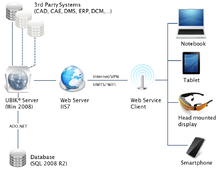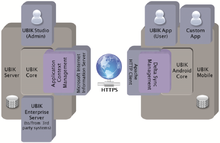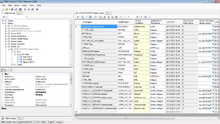Introduction
A complete UBIK® System consists of a few parts that play together but have different purposes. Not every component (or access to it) is needed for each and every scenario and sometimes these components are spread over various servers and devices. The only part that is always necessary and therefore not listed in this table is the UBIK® Database. The following table should provide an overview which part of UBIK® has to be installed and accessible for which use case:
| Use case/Component | UBIK® Studio | UBIK® Web Services | UBIK® Enterprise Service | UBIK® Mobile Client |
|---|---|---|---|---|
| Data model administration | Yes | No | No | No |
| Manual interfacing to 3rd party systems | Yes | No | No | No |
| Automated interfacing to 3rd party systems | No | No | Yes | No |
| Mobile working | No | No | No | Yes |
Installation
UBIK® Studio
UBIK® Studio can be installed and used on a local client as well as via a Remote Desktop Connection (RDP). All the structural and content data are stored in the UBIK® database managed by a Microsof SQL server. A Microsoft Internet-Information-Server (IIS) serves as platform to publish this data to the mobile device. A necessary but obvious condition is of course, that all the software packages (UBIK® Studio, Microsoft SQL and IIS) can communicate between each other.
- See How to install UBIK® Studio for help on installation issues.
- See UBIK® Studio Basics for further details on configuration.
UBIK® Enterprise Service
The UBIK® Enterprise Service is a Windows service that is meant to automate UBIK® interface components or interface workflows. It typically runs on a server and is triggered by changes in an arbitrary amount of folders in the file system (like new or modified files).
- See How to install UBIK® Enterprise Service for help on installation issues.
- See UBIK® Enterprise Service for further details about configuration.
Database (SQL)
- See Set up UBIK® Database for help on configuration issues.
UBIK® Web Service
The UBIK® web services publish data from the UBIK® database to a mobile device (eg mobile phone, tablet).
- See How to install UBIK® Web Service for help on installation issues.
- See UBIK® Web Service for further details about configuration.
Data- and Object Modeling
Get to know about the relational data- and object model used in UBIK® beginning from a rather figurative and abstract point of view.
Based on the UBIK® meta model a set of MetaClasses and MetaProperties have been already implemented in advance. These objects serve as root nodes for more user specific MetaClasses or containers for a range of functionality. New customer specific meta objects are derivatives of those system objects, hence implicitly inherit a set of MetaProperties and features.
The most important system objects are:
Interfacing
- See Interfacing for a comprehensive list of interfacing topics.
Interface Manager
Used to configure Interface components and Interface Workflows


